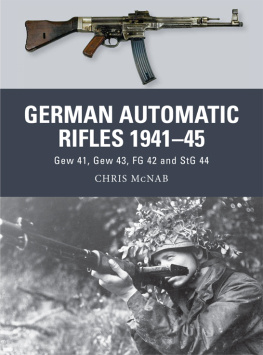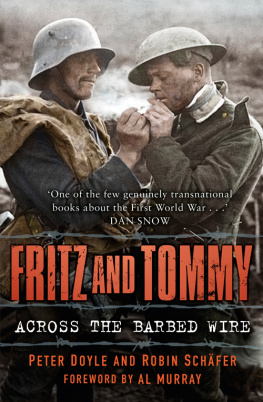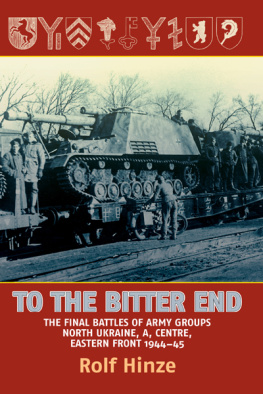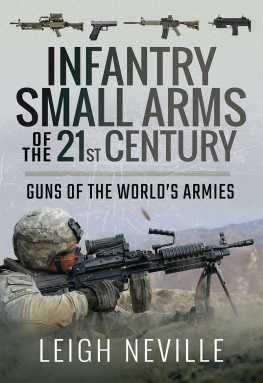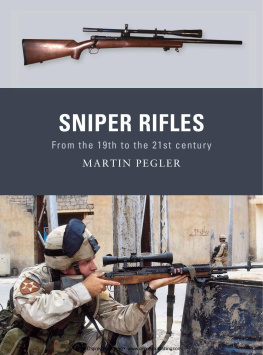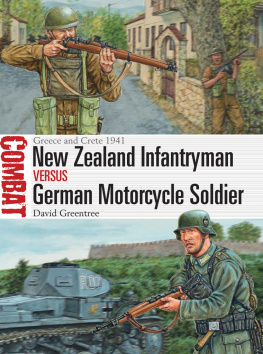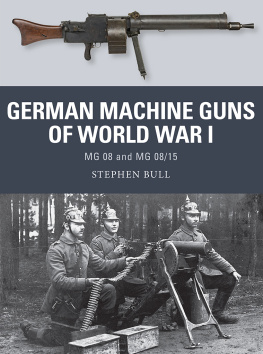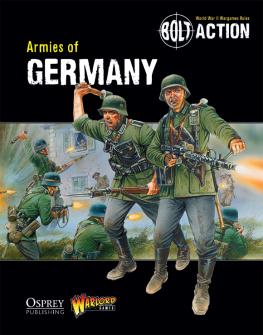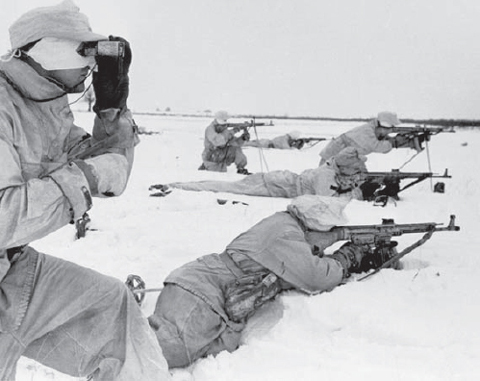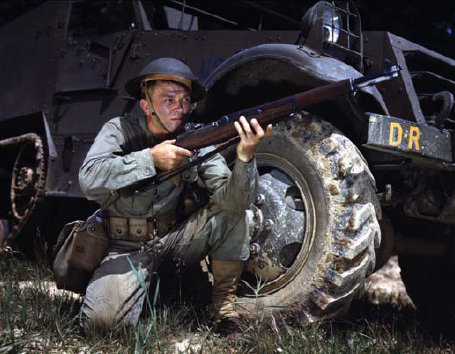GERMAN AUTOMATIC RIFLES 194145
CHRIS McNAB
Series Editor Martin Pegler
CONTENTS
INTRODUCTION
There is no denying that the bolt-action rifle changed the face of warfare. From its origins in the 1830s until the end of World War II (193945), the bolt-action rifle became the defining firearm of most of the worlds modern armies (the United States became a forward-thinking exception with its adoption of the M1 Garand from 1936). It offered an enduring battlefield package. Weapons such as the 7.92mm Mauser Gewehr 98, the .303in Short Magazine Lee-Enfield and the .30-06-calibre Springfield M1903 were resilient, powerful, generally easy to handle and could be frighteningly accurate to long ranges in the trenches of World War I, exposing just a fraction of skull above the trench parapet would likely result in death by head-shot from an opposing sniper.
Yet for all the undeniable merits of the bolt-action rifle, by the end of World War I (191418) most combatant nations were as aware of the weapons limitations as its benefits. The guns were long, heavy and cumbersome, not least in the dynamic horrors of close-quarters trench combat, where a rifle measuring 1,255mm (in the case of the Gew 98) was awkward to wield with speed against multiple targets. The operating mechanism the manual working of a bolt system was a world of improvement over the arm-aching days of muzzle-loading, but it was still sluggish when fleeting enemies had to be engaged instinctively. (Maximum rate of fire for a well-trained rifleman with a smooth-running gun was about 15rpm.) Furthermore, many began to question the actual value of the rifles reach. A potent cartridge such as the 7.9257mm Mauser or 850mmR Lebel could kill targets the shooter could scarcely see, let alone hit, unless using expensive visual accessories such as telescopic sights. In fact, German combat studies in the 1920s (about which more later) suggested that most actual combat took place at ranges of around or below 300m, meaning that the shoulder-bruising thump of the full-power rifle round, and the arcing flight of the bullet towards the distant horizon, were generally unnecessary.
For these reasons, the bolt-action rifle was, during the first half of the 20th century, largely sandwiched between two types of firearm in an army the submachine gun and the machine gun. The submachine gun, a full-auto weapon firing pistol-calibre ammunition, gave short-range (up to about 150m) rapid firepower ideally suited to close-quarters combat. The machine gun, by contrast, dealt out long-range attrition using a broad beaten zone of fire and a rate of fire that even multiple riflemen could not hope to match. The bolt-action rifle remained in the middle ground redoubtable, powerful, functional and ubiquitous.
There was, however, another way forward for the rifle. Within years of the birth of automatic firepower, courtesy of Hiram Maxims recoil-powered machine gun in 1883, resourceful minds were looking at ways in which to apply the principles of self-loading to rifles. (The advent of bulky self-loading handguns such as the Borchardt Selbstladepistol of 1893 had at least proved that semi-automatic principles could be applied to hand-held firearms.) The original innovators in this regard were the Mexican Manuel Mondragn and the appropriately named Danish inventor Soren H. Bang. During the 1890s and the early years of the 20th century, both gunmakers developed weapons that used propellant gas to cycle the weapon through loading, firing, extraction and ejection, the cycle being performed each time the trigger was pulled. The Bang rifles (he developed several such firearms) used a system in which a muzzle cone caught the propellant gas on firing. The gas in turn pushed the cone forward and worked an operating rod attached to the bolt mechanism, unlocking and retracting the bolt and performing the ejection and reloading cycle. The Bang system was not a commercial success; his rifles were unreliable and complex, and so never went into production. They are significant for our study here, however, because the Bang principle actually went on to inform the German Gew 41 automatic rifles.
The Mondragn rifle utilized a different, and more visionary, method of operation. It applied the gas-operation system still fundamental (with much variation) to many of the worlds automatic rifles and light machine guns. Propellant gas was tapped off from the barrel to mechanically unlock the bolt and power it to the rear against the recoil spring. The bolt was of a rotating type, lugs on the bolt head locking into projections to the rear of the breech, and it rotated through its locking/unlocking motion via projections on the cocking handle engaging with helical grooves in the bolt body. Almost in acknowledgement that the worlds military community did not quite yet trust semi-automatic weaponry, the Mondragn rifles gas system could be disconnected from the bolt system, converting the firearm back into a conventional straight-pull bolt-action rifle.

A German soldier sits at his post on the Eastern Front in 1942. Stacked in front of him are Kar 98k bolt-action rifles, the standard firearm of the Wehrmacht in World War II. German experiments in automatic rifles aimed to transform the firepower of the individual rifleman. (BArch, Bild 101I-394-1459-16, Wanderer, W.)
A US infantryman at Fort Knox, Kentucky, in 1942 displays his .30-calibre M1 Garand. The M1 was historys first standard-issue self-loading rifle, and it had a revolutionary effect on the combat potential of US Army and Marine Corps units. (US Office of War Information Collection 12002-34)
Although the later M1 Garand rifle would be the worlds first standard-issue semi-auto rifle, the 757mm Mondragn was nevertheless one of the first actually to enter military service, with the Mexican Army in 1908. It was not a production success, however, despite commercial realities forcing it into manufacture with the capable SIG (Schweizerische Industrie Gesellschaft) firm, of Switzerland. Just 400 weapons were actually in the hands of the Mexican forces by 1911 (of 4,000 ordered), and SIG was left with about 1,000 unsold guns in stock. Interestingly, in 1915 SIGs Mondragn rifles were purchased by the fledgling German air force, modified to 30-round helical snail magazines (they had previous fired from eight-round clip-loaded magazines) and issued as self-defence weapons to the aviators. The rigours of wartime service were not kind to the fragile Mondragn, so they were rather quickly withdrawn from front-line service. Yet Manuel Mondragns legacy remained in his essentially sound principles of gas-operated weaponry.
The sheer cost of a semi-auto weapon compared to a bolt-action rifle, especially in moments of wartime exigency, meant that semi-auto weapons were an expensive diversion. The period from 1900 to 1918 nevertheless saw a steady expansion in the number of semi-automatic weapons in soldiers hands, although often on an experimental basis, and always in limited numbers. The French company Manufacture dArmes de Saint-Etienne produced the RSC Modle 1917, an ineffectual and ugly gas-operated rifle chambered for the 850mmR Lebel. More interesting was the 6.552mm Cei-Rigotti (named after the eponymous captain responsible), an Italian self-loading carbine actually developed in 1900. This futuristic weapon was gas-operated via a short-stroke piston system, the rotating bolt featuring two lugs that locked into recesses in the barrel extension. Not only could it fire from 10-, 20- or even 50-round detachable magazines, but it was also historys first selective-fire weapon a selector switch allowed the user to choose between semi-auto and full-auto fire. No one saw past the Cei-Rigottis teething troubles, so the weapon was another commercial failure, although the fact that carbines such as the US M1 later used a similar system hints at its importance.

